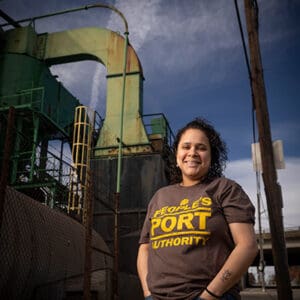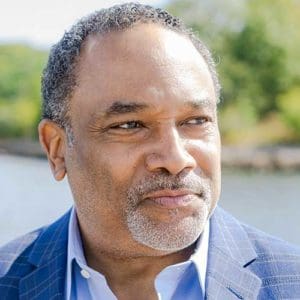How does a community begin to fight back against pollution, disinvestment, and decisions made without its voice? Does it start with writing letters to lawmakers? Lawsuits?
Often, it begins with something simpler but far more powerful: neighbors coming together.
They gather in church basements, school gyms, and neighborhood parks. They share meals and stories. They point to the factories crowding their streets, the trucks idling near playgrounds, the tank farms sitting just steps from their homes. But just as importantly, they talk about what they want – not just what they’re fighting, but what they’re building.
Before any campaign or court case, there’s a shared vision.

“My community is still in need of clean air, clean water, clean spaces,” says Monica Huertas. A mother and doula, Huertas also serves as executive director of the People’s Port Authority, a Rhode Island environmental justice community organization led by residents of South Providence and Washington Park. “That’s what keeps me going – just the sheer need for healthy living.”.
That simple hope sits at the heart of environmental justice: communities demanding fairness and reclaiming the power to shape their own future.
South Providence: A Neighborhood Worth Fighting For
For Huertas, the path to environmental justice started with her own home. After years of housing instability, she and her husband bought a house in South Providence’s Washington Park neighborhood. They loved the mix of single- and multi-family homes, students and retirees, fast food workers and firefighters.
“We were really particular about being in this neighborhood,” she says. “It was diverse, working class, and proud. That’s what I loved – that mix.”
But beyond Washington Park’s porches and playgrounds lay a legacy of decisions made by city planners, port authority appointees, and corporate executives, who, for decades, treated this neighborhood as a sacrifice zone.
Huertas soon discovered what else came with her new home: a reeking oil tank farm, a grit- and fume-spewing asphalt plant, and hulking metal scrapyards. The port’s industrial developments filled the air with fumes that drifted into homes. And through it all, critical decisions were made with little input from those who lived in the area.
The message was clear: This neighborhood – and these neighbors – didn’t count.

“In South Providence, families breathe some of the most polluted air in the state,” says Darrèll Brown, CLF’s vice president for Rhode Island, who leads the organization’s work to address environmental justice issues in the state, including the Port of Providence. “These aren’t random outcomes – they’re the result of decisions and systems that treated some people’s neighborhoods as less worthy of protection.”
“Environmental racism is real,” he continues.
What’s Environmental Justice?
“Environmental justice has more of an impact when it’s not there – because then you feel the weight of everything that’s missing,” says Linda Perri, president of the Washington Park Association on Providence’s South Side. What’s missing often starts with clean air, safe water, and reliable housing. But just as critically, environmental justice is about power. Who decides what gets built and where? Who is heard when policies are written?

“Environmental justice isn’t just about fighting harm,” says Britteny Jenkins, vice president for environmental justice at CLF. “It’s about shifting power. It’s about making sure communities most affected by environmental decisions are also the ones shaping them.”
And the fight isn’t only about surviving. It’s about joy, rest, and care.
“We’re not going to die trying not to die,” Huertas says. “Environmental justice is also about living – about joy, healing, and rest. If you’re breathing clean air, if you’ve got a fan in 102-degree weather, that’s environmental justice, too. A pedicure, a meal, a day of childcare – that all makes a difference for self-care. And that’s environmental justice, too.”
Beyond Providence: A Region-Wide Fight
Across New England, in communities disproportionately affected by pollution, neighbors have refused to accept that their homes – and their health – must be the sacrifice zone for polluting industries. And their efforts have paid off.
“We’ve planted 47 trees along Allens Avenue,” recounts Perri. “We’ve reported illegal dumps. We’ve stopped people from stealing the waterfront. Every single one of those things was a fight – but we did it.”
And the victories don’t stop there. Residents in the Port of Providence blocked a proposed expansion of a liquefied natural gas terminal, pressured regulators to investigate tar odors, and stopped the construction of a plastic-burning plant and a waste transfer station. And today, they are pushing for greater oversight of a scrap metal facility – work that once felt nearly impossible.

Each hard-won victory has proven what’s possible when communities organize for justice.
But the fight for environmental justice isn’t limited to one neighborhood. “These fights may look different from place to place,” says Jenkins, who oversees CLF’s environmental justice work across the region. “But step back, and the root causes are the same: Systems that have long underinvested and undervalued Black, Brown, and working-class communities. Look closer, and you’ll see something even more powerful – families and neighbors leading with a clear vision, driving change, and refusing to be ignored.”
These fights echo across New England. In Nashua, New Hampshire, community advocates stopped a proposed asphalt plant near homes and schools. In Springfield, Massachusetts, residents are fighting a biomass incinerator that would worsen air pollution in a city already facing high asthma rates. And, in Maine, the Penobscot Nation is challenging the expansion of Juniper Ridge Landfill, where out-of-state waste threatens their land and waters.
Together, these local battles are reshaping what justice looks like across New England.
Big Challenges Require Bold Action
And so, community groups are responding with bold ideas. In Providence, dozens of organizations – including the People’s Port Authority, the Racial and Environmental Justice Committee, and the Washington Park Association – have been pushing for systemic change. There are many forms an environmental justice law could take – one of those could include a green justice zone.
These proposed zones would identify neighborhoods most harmed by industrial pollution and zoning decisions – and direct investment to repair that harm.
“Basically, Green Justice Zones are green patches of the future,” says Huertas. “We want to include clean air, clean water – but also housing and jobs. That’s environmental justice as we define it. This policy says you need to fix the places that have been more disadvantaged, the places that have been systematically left out, because it’s not a thing that just happened – it was done on purpose.”
So, what does that really mean?
“Does it mean that you can’t have an extractive economy [industries taking natural resources like oil, gas, or minerals for profit without reinvesting in the local community]? Does it mean that there’s no more expansion in the port? Does it mean that you have to phase out the companies that are there now?” she asks. “Yes. That’s what that means!”
And that vision – of communities defining justice on their own terms and leading the fight – is working
“What’s happening in South Providence is powerful,” says CLF’s Jenkins. “Residents are setting the agenda. They’re defining justice on their terms and not waiting for organizations like CLF. But we’re here to back them up with the tools we have – legal, scientific, policy – so they can bring that vision to life.”
Showing Up Differently: CLF Is Redefining Partnerships
CLF has long been committed to environmental justice, but in recent years, we have deepened our commitment to true partnership.
“There was a time when we weren’t doing enough in places like South Providence,” says CLF’s Brown. “We’ve had to ask: Are we truly listening? Are we standing beside the community – or in front of it?”
CLF’s role today looks different. Legal briefs are still part of the work – but so are policy trainings, community gatherings, and flyers translated into multiple languages.
“True partnership means we don’t take over,” Brown adds. “We show up where we’re invited, and we bring our tools in service of the people already doing the work.” What that looks like in practice varies from state to state, and even from community to community.
We were there in the fight against that asphalt plant in Nashua, with a CLF community organizer supporting residents on the ground and a legal advocate exploring options to stop the plant from receiving its building permit. In Springfield, we have fought alongside community partners and city councilors for more than a decade to challenge the proposed biomass plant in court. In Huertas’ Providence neighborhood, we have led the legal effort to hold Shell Oil accountable for its polluting tank farm, while supporting partners in their push for the establishment of a green justice zone in the General Assembly.
And regionwide, CLF has worked with community partners to enact environmental justice laws in every New England state – an effort that continues today. “We’re trying to make sure there are legal structures that reflect what people have been demanding for decades,” Brown says. “Not just cleaner air – but actual say over what gets built and how.”
A Future That Belongs to Everyone
Environmental justice work is slow. It doesn’t always come with ribbon cuttings, front-page stories, or major court victories. But it’s the kind of work that builds lasting change.
When these systems of harm are removed, communities are stronger. Safer. More competitive. People are able to live out the American dream – on their own terms.
– Darrèll Brown, CLF’s vice president for Rhode Island,
That future is already underway in Rhode Island. And at the end of the day, it’s not just about the small or big wins but about what the community creates. “Together, we’ve been able to build this big grassroots movement in tiny little Providence,” says Huertas.
Environmental Justice Isn’t Just Urban

When thinking about environmental justice, many of us envision city neighborhoods surrounded by highways or factories. But in rural New England, the challenges are just as real – and often harder to spot.
People assume rural means untouched or pristine.But many rural areas are still fighting against a legacy of pollution, poor infrastructure, and limited political voice.
– Britteny Jenkins, CLF’s vice president for environmental justice.
Many rural communities are pushing back against decades of disinvestment, rising energy costs, and decisions made without their input. Residents of mobile home parks – who make up about 8% of households in Maine and Vermont – often stand at the front lines, leading efforts to rebuild after storms, fight flooding, and demand safer infrastructure.
In Maine, CLF is working with the Penobscot Nation to challenge harmful dumping at Juniper Ridge Landfill, where out-of-state waste threatens tribal lands and nearby waterways. And last July, CLF took the fight to court alongside the local community and tribal members, protecting their right to clean water and a safe future. In northern Vermont, residents know the risks of extreme weather and years of underinvestment – flooded roads, unstable housing, soaring energy costs. They’ve rebuilt before, and they know what it’ll take to prevent even worse.
But just like in urban neighborhoods, rural residents aren’t only fighting back – they’re building something better. In 2022, Vermont passed its first environmental justice law thanks to the leadership of rural residents, mobile home communities, and housing advocates. The law ensures that state decisions better protect communities from flooding, pollution, and other harm.
“It’s about connection, culture, and care,” Jenkins says. “Whether you live in the middle of a city or on the edge of a forest, everyone deserves a healthy place to call home.”
At its heart, environmental justice is about who gets to shape solutions. “Whether it’s diesel in Providence or drinking water in a rural town,” Jenkins says, “the principle is the same: people closest to the problem should be closest to the solution.”
